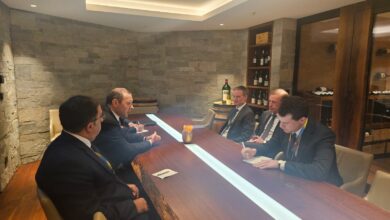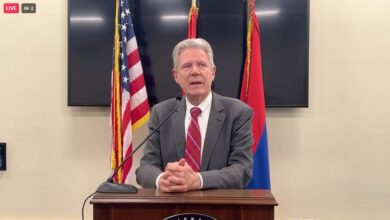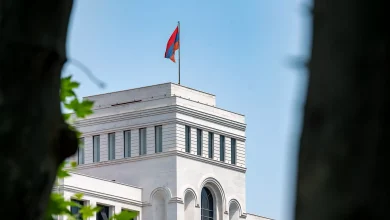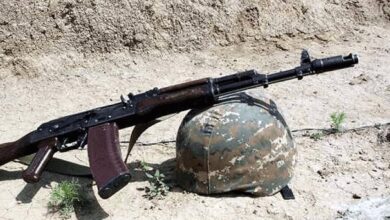Dear people, dear citizens of the Republic of Armenia,
Starting from today, May 24, 2024, the border guard troops of the National Security Service of the Republic of Armenia took over the protection of the 1.9 km section of Berkaber settlement, 4.9 km section of Voskepar and Baghanis settlements of the state border of the Republic of Armenia.
Protection of the 5.8 km demarcated section of the Kirants settlement of the state border will be carried out by a transitional scheme until July 24, 2024.
This border demarcation process is understandably the most discussed topic of recent months, and I consider it important that each of us, each citizen, has a clear answer to the following questions: what is happening in our country, what is happening with our country, why is it all happening, what are the possible scenarios and alternatives after this point?
The key factor from which the current processes derive is the strategy that the government of the Republic of Armenia has put on its table. That is the strategy of Real Armenia, the strategy of Armenia, the gilded map-image of which I show you at every opportunity. That’s the Armenia I am talking about.
And why should this map cause debates and inflame passions? For a simple reason. not only in the previous 33 years, but also before that, the subject, goal and destination of our social psychology was not this Armenia.
And there were objective reasons for this. The most important of those reasons is our national misfortune of not having a state for centuries, which in itself should keep the dream of restoring statehood alive in our consciousness and subconsciousness, which has been the most important component of our national identity.
But while dreaming of a state, we relied on the memories that came from the state tradition we had in the past. Armenia of Yervanduni dynasty, Armenia of Artashesian dynasty, Armenia of Arshakuni dynasty, Armenia of Bagratuni dynasty, Cilician Armenia. Those Armenias were not identical and comparable with each other in terms of their territory and sometimes geographical location, which became an objective obstacle for the concretization and objectification of our ideas about Armenia.
This may seem not essential, but imagine you want to build a house, but you are not sure in which area, in what location, what size house you want to build. Until your understanding of these matters becomes concrete, you cannot build that house and your efforts to build it will never come to fruition. The most you will have is chaotic actions, because you do not decide in which area you want to build a house, in what position, in what size.
During the short period of existence of the First Republic, we did not manage to become concrete in our ideas about the Republic of Armenia.
The Second Republic was the Soviet Republic, which was not a sovereign state, but a country within the USSR, and due to this fact, it was a hostile environment for thinking about independence and an independent Armenia. Those with such thoughts and ideas were subject to criminal prosecution and were a threat to the integrity of the Soviet Union.
One of the methods of the Soviet Union’s struggle against the strong national self-awareness of the Armenians was to direct the independence dreams of the Armenian SSR outside the territory of Soviet Armenia and the Soviet Union, sometimes geopolitically, and sometimes in order to weaken and eradicate the perception of the Armenian SSR as a potential area for the re-creation of Armenian statehood. The Soviet Union promoted the formula of seeking a homeland outside the Armenian SSR among Armenians.
Due to this and a number of other factors, the search for the homeland became one of the pillars of our Armenians’ subconscious. This formula of searching a homeland from inside the homeland was harmless for the Soviet Union, because it directed the dreams of re-establishing statehood from the Armenian SSR, sometimes even outside the territory of the USSR, which also became a geopolitical factor that the Soviet Union could use in its international relations.
And those who still tried to connect the feelings of Armenian statehood with Soviet Armenia, ended up in prisons and on the political margins as carriers of anti-Soviet activities, that is, their supporters did not multiply.
Here, it is in the conditions of the mentality of searching a homeland, a state outside the homeland, that the Third Republic of Armenia was formed, which positioned itself not as a means of ensuring the freedom, security and well-being of its own citizens, but adopted a vision that fully and completely fit into the Soviet-Armenian formula of the search for a homeland.
This is where we found ourselves in the situation described above, when we are not sure on what territory we want to build a state, in what position we want to build it and in what size.
And the search for homeland was reaffirmed as the key socio-psychology of the Third Republic.
A huge part of the deep problems of the Third Republic is related to this.
I cannot boast that I had this understanding and realized these conceptual nuances all the time or throughout my prime ministership. I have dealt with this agenda in a systematic way after assuming the position of the Prime Minister of the Republic of Armenia, seeing in depth and practically the threats that hang not only on the security of the Republic of Armenia, but also on the existence of our state in general.
And therefore, the conceptual question, the solution of which I have considered vital as the prime minister, is as follows: how are we going to ensure the lasting and prosperous future of the Republic of Armenia?
Strategic thinking on these issues led me to the Peace Agenda and the vision of Real Armenia, which are deeply interconnected.
If our strategic vision is not the Real Armenia, the already difficult peace will not be possible at all, because our environment will consider us a strategic threat and therefore will do everything to either physically destroy our statehood or prevent its development.
And secondly, when we do not spend our limited resources and energy on the strategic needs of Real Armenia, we do not have the results we could have and the development of Armenia, the future of our children is hindered doubly. And the peace that the Republic of Armenia needs so much is becoming more and more unattainable.
Under these conditions, the sovereignty of our country is significantly damaged, because when your ideas about the motherland do not exactly match with the internationally recognized legitimate borders of your country, you are forced to open the door for the disproportionate influence of others, because it seems to you that in this way you get strength and support to advance your agendas that do not coincide with legitimate borders.
So here we are again in the Soviet-Armenian model of patriotism. It is this model that separated the concept of homeland from the concept of state, solving the practical problem that the Armenian people should not consider the state of the Armenian SSR, even if incomplete, as a homeland, because the next step after considering the state as a homeland would be deepening the consciousness of independence.
Contrary to various assessments, our government is not separating, but trying to re-unite, to equate the concepts of homeland and state, because this is the only way to accomplish and strengthen the Republic of Armenia, otherwise we will spend our already limited resources on the search for a homeland, jeopardizing the future of the motherland-state.
As one of you who received a mandate from you to work on the formulas to ensure the future of Armenia, I spent years thinking about this epoch-making agenda, this tangle, before and after the 44-day war. And my thoughts have brought me to the unequivocal conviction that our duty to the future and future generations, as well as to the real people living in the Republic of Armenia today, requires us to do everything to make sovereign and democratic Armenia with demarcated borders a national and state ideology and concept.
And the discussions that are taking place in our country are not a surprise to me, because I have personally gone through that painful path, from the psychology of Historical Armenia to the psychology of Real Armenia, and we are going through that same path together now.
We are going through that path and at the end of that path is our Promised Land, the Republic of Armenia, with the difference that we are already here, but very often we do not notice our Promised Land, and because of not noticing it, we continue our search for the Promised Land. Today, our country is not perfect, also because of our endless search for the Promised Land inside the Promised Land does not allow us to make concrete and formulate the answer to the question of which area, in what position, of what size we want to build a home-state, and the demarcation process formulates the answer to this question column by column.
And together we must cross go through this path, which yes, is not covered with a red carpet, but passes through thorns and pitfalls, hard and difficult decisions, disappointments and misunderstandings, but it is the only one that has a horizon ahead of it and leads to the real Promised Land, Real Armenia: the Republic of Armenia. This is a crucial road. One philosopher says that the best path is the one that gets you where you are. This path brings us to where we are, the Republic of Armenia, and gives us the opportunity to look at our reality from a completely different perspective. And it is only from that point of view that the future and the route to that future can be seen.
There is only one guarantee to complete that road. popular knowledge and conviction in the mission of the political leadership.
Our political team and I live with that mission and we see that we have put a formula on the table that will guarantee the 29 thousand 743 square kilometers of the internationally recognized legitimate territory of the Republic of Armenia and the borders that surround that territory, and our task is not only to lead, but also to to inspire the people, the citizens of the Republic of Armenia with that vision and formula, because this is a formula, a movement that leads us to real independence and sovereignty, territorial integrity and inviolability of borders. This is a formula that will give our talented people, each and every one of you, the opportunity to concretize and enjoy the results of their work in the person of a free, fair, safe, prosperous and happy Armenia.
I presented in detail at the May 7 press conference how, in what sequence of steps we will achieve this goal, and I don’t see the need to repeat the same in other speeches and in this format.
The main purpose of this message is to clarify, comment on what is happening in our country, with our country, and why it is happening.
The establishment of the real Armenia is taking place in our lives and in our consciousness. It is a difficult, painful process that we go through and must go through together. It is a movement for independence and sovereignty that we must bring to its final destination, and my political team and I consider this our mission. Our mission is to make the state, independence and sovereignty a means that serves the citizen and not vice the versa.
Both in 2018 and 2021, the proud citizens of the Republic of Armenia have given us a mandate to ensure the future of the Republic of Armenia, and this mandate must be fully and completely implemented.
Glory to the martyrs and long live the Republic of Armenia.
And long live our children who will live in Free and Happy Armenia.








